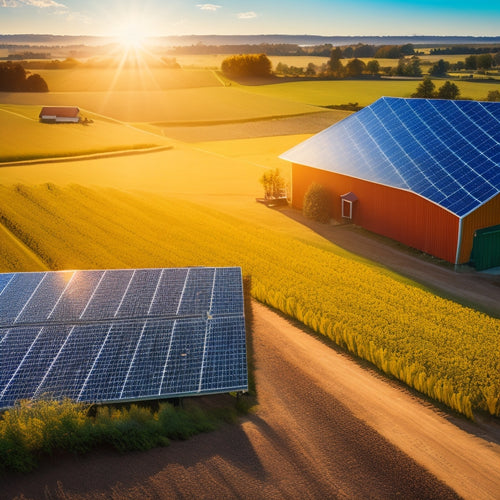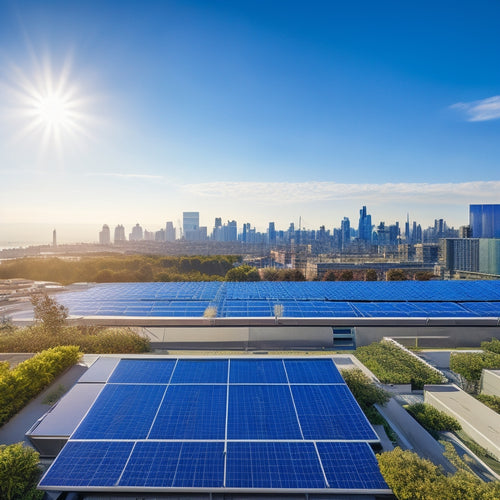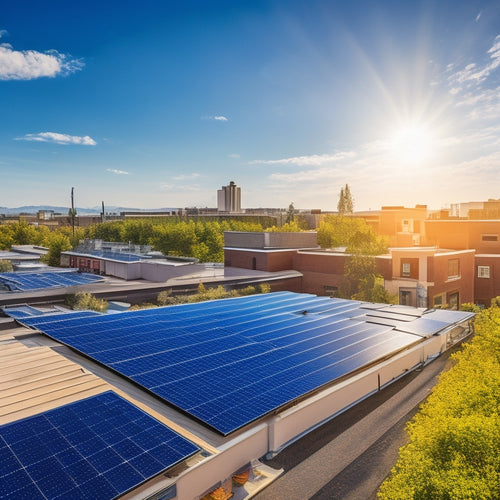
Community Solar Projects for Local Businesses
Share
Community solar projects can considerably lower your energy costs while providing access to renewable energy without the need for individual installations. You could save up to 75% on your electricity bills, resulting in long-term financial stability and predictable budgeting. These projects enhance sustainability by reducing reliance on fossil fuels and promoting environmental stewardship among local businesses. With lower upfront costs and financial incentives like tax credits, they're a practical choice for many. As you investigate your options, you'll find more understandings that could help optimize your energy strategy for better savings and sustainability.
What You Need to Know
- Community solar projects offer local businesses significant cost savings, typically reducing energy expenses by $50/month compared to traditional utility rates.
- These initiatives enable access to renewable energy for businesses that cannot install solar panels, promoting local sustainability efforts.
- Participation in community solar fosters environmental stewardship by reducing reliance on fossil fuels and lowering greenhouse gas emissions.
- Community solar enhances energy independence, providing businesses with financial stability against price fluctuations in traditional energy markets.
- Clear energy goals and evaluating financial incentives are essential for selecting viable community solar projects that align with sustainability objectives.
Local Energy Cost Savings
Community solar projects can considerably reduce your energy expenses by allowing you to share the benefits of renewable energy generation.
By utilizing space optimization strategies, local businesses can enhance their operational efficiency while benefiting from lower energy costs.
By participating in these initiatives, you not only lower your monthly utility bills but also enjoy long-term financial advantages as energy costs stabilize over time.
Analyzing these savings can provide a clearer illustration of how community solar contributes to both individual and local economic resilience.
Reduced Energy Expenses
Through the implementation of community solar projects, residents can considerably lower their energy expenses while contributing to sustainable energy solutions. By utilizing the power of the sun, you can enjoy energy efficiency and actively engage in sustainable practices without the upfront costs of traditional solar installations.
The following table illustrates potential savings based on participation in a community solar project compared to typical energy costs:
| Energy Source | Monthly Cost | Savings |
|---|---|---|
| Traditional Utility | $150 | - |
| Community Solar | $100 | $50 |
| Renewable Credits | $120 | $30 |
Long-term Financial Benefits
Investing in community solar projects offers considerable long-term financial benefits, particularly regarding local energy cost savings. By participating in these initiatives, you can lock in stable energy rates, reducing your exposure to fluctuating utility prices. This predictability allows you to plan your budget more effectively, ultimately freeing up resources for other business needs.
Additionally, these projects can lead to immediate savings on electricity bills, as participants often see a reduction of 50-75% in energy costs through on-site energy generation cost savings and financial benefits.
Moreover, community solar projects often come with tax incentives that can greatly enhance your investment returns. These incentives can take the form of tax credits, grants, or rebates, all designed to lower the initial investment burden. As you benefit from these financial aids, your overall return on investment can improve, making the project even more attractive.
Another aspect to reflect on is the potential for increased property values. By investing in renewable energy sources, you position your business as environmentally responsible, which can appeal to customers and investors alike.
Increased Renewable Energy Access
Community solar projects offer affordable energy solutions that can greatly enhance your access to renewable energy.
By participating in these initiatives, you not only contribute to energy independence but also benefit from lower energy costs.
Additionally, these projects can promote community engagement and support local economies, much like how space-saving designs in bathroom storage cabinets maximize compact areas.
This accessibility can strengthen communities, making clean energy a realistic option for everyone.
Affordable Energy Solutions
Increasingly, community solar projects serve as an essential solution for enhancing access to renewable energy, especially for those who may not have the means to install solar panels on their properties. These initiatives enable you to invest in solar energy without the upfront costs associated with traditional installation.
By joining a community solar program, you can enjoy the benefits of renewable energy while supporting local sustainability efforts. Additionally, many community solar programs are designed to maximize energy production and efficiency, allowing you to benefit from discount solar panels that are both cost-effective and environmentally friendly.
Moreover, community solar projects often encourage energy efficiency. They motivate you to reduce your energy consumption, leading to lower utility bills and a reduced carbon footprint. Many programs also come with solar incentives, such as tax credits and rebates, making it easier for you to shift to cleaner energy sources.
These affordable energy solutions not only enable you as a consumer but also nurture a sense of community. By participating, you contribute to a collective effort that prioritizes environmental health and economic resilience.
Ultimately, community solar projects bridge the gap between the desire for renewable energy and the practical challenges of accessing it, ensuring that everyone can benefit from a sustainable energy future.
Energy Independence Benefits
As more individuals gain access to renewable energy through community solar projects, the benefits extend beyond affordability to promote energy independence. By participating in these initiatives, you're not just contributing to a sustainable energy future; you're actively engaging in energy resilience strategies that help buffer your community against fluctuations in energy prices and supply disruptions.
Additionally, these projects can lead to significant long-term savings on energy costs, creating financial stability for local businesses cost reduction and financial benefits.
Community solar projects allow you to reduce dependency on traditional energy sources, which often come with unpredictable costs and environmental concerns. These initiatives encourage local engagement, enabling you and your neighbors to take control of your energy needs.
The collaborative nature of community solar encourages collective investment in renewable technologies, creating a more stable and resilient energy system for everyone involved.
Moreover, by supporting community engagement initiatives, you're reinforcing social ties and economic stability. The more you invest in local renewable resources, the stronger the push for energy independence becomes.
This not only enhances your personal freedom but also contributes to a more sustainable and equitable energy environment. In this way, community solar projects serve as a powerful tool for achieving both energy independence and environmental stewardship.
Key Benefits of Community Solar
Community solar projects offer significant cost savings opportunities for participants by lowering energy bills and providing access to renewable energy without the need for individual installations.
Additionally, these initiatives contribute to a reduction in environmental impact, promoting cleaner energy sources and decreasing reliance on fossil fuels.
Understanding these benefits can help you make informed decisions about your energy consumption and support sustainable practices in your community.
Cost Savings Opportunities
Participating in community solar projects offers significant cost savings opportunities that can benefit both households and local economies. By joining these initiatives, you can access renewable energy without the need for expensive installations on your property.
This energy collaboration allows you to share resources with local businesses and neighbors, thereby reducing individual costs and enhancing overall financial stability.
Community solar programs often provide lower electricity rates compared to traditional energy sources. This is particularly advantageous for small businesses, which can redirect those savings toward growth and development.
Additionally, by engaging in sustainable partnerships, you contribute to a more resilient local economy. When multiple stakeholders work together, they can utilize economies of scale, making solar energy more affordable for everyone involved.
Moreover, community solar projects can pave the way for future investments in renewable technology, which are typically less volatile in pricing than fossil fuels. Your participation helps to create a more sustainable energy environment while also promoting financial savings.
This approach not only enables you to take control of your energy costs but also encourages a sense of community, aligning with your desire for freedom and independence in energy choices.
Environmental Impact Reduction
Joining a community solar project not only leads to financial benefits but also plays a significant role in reducing environmental impacts. By participating in these initiatives, you help decrease reliance on fossil fuels, which is fundamental for combating climate change. Each kilowatt-hour generated from solar energy contributes to lower greenhouse gas emissions, promoting cleaner air and a healthier ecosystem.
Moreover, community solar projects encourage sustainability practices among local businesses and residents. As you engage with your community, you're not just investing in renewable energy; you're nurturing a culture of environmental responsibility. This collective effort can inspire others to adopt similar sustainable practices, amplifying the positive effects on the environment.
Community engagement is another essential aspect. When you join forces with your neighbors, you create a shared vision for a sustainable future. This collaboration strengthens community ties and enables everyone to take part in the shift to renewable energy sources.
Ultimately, by choosing community solar, you're making a conscious decision that reflects your values and commitment to environmental stewardship, ensuring a cleaner, more sustainable world for future generations.
Selecting Based on Energy Goals
When selecting a community solar project, it's crucial to define your energy objectives clearly.
Understanding what you aim to achieve—whether it's reducing costs, enhancing sustainability, or maximizing energy independence—will guide your decision-making process.
Additionally, evaluating financial incentives can help you assess the overall value of various projects aligned with your goals.
Defining Energy Objectives
Defining energy objectives is an essential step in selecting the right community solar project that aligns with your sustainability goals. You'll want to contemplate how these objectives fit within your broader energy diversification strategies. Are you looking to reduce your carbon footprint, stabilize energy costs, or enhance energy resilience? Each goal will guide you toward different project options and partners.
When defining your energy objectives, think about the specific outcomes you desire. For instance, if your aim is to cultivate community engagement, a project with collaborative funding models could be ideal. This approach not only supports shared investment but also promotes local participation, nurturing a sense of ownership and responsibility among stakeholders.
Moreover, you should assess how these objectives can complement existing initiatives. By aligning with your business's operational strategies, you can create a cohesive plan that maximizes the benefits of solar energy while minimizing risk.
Evaluating Financial Incentives
Selecting the right community solar project involves not just understanding your energy objectives but also examining the financial incentives that can enhance the viability of your chosen initiative. Financial incentives can greatly impact your project's cost-effectiveness and overall success.
Start by exploring available tax credits. Federal and state programs often provide substantial tax benefits for businesses that invest in solar energy. These credits can reduce your tax burden, allowing you to allocate those savings elsewhere in your operations. Make sure to research eligibility requirements and application processes to maximize your benefits.
Next, consider grant opportunities. Many local and federal organizations offer grants specifically for renewable energy projects. These funds can help cover upfront costs, making solar installations more accessible. Be proactive in identifying programs that align with your business goals and energy objectives.
Lastly, examine the long-term financial sustainability of your community solar project. By evaluating these financial incentives, you can make an informed decision that not only meets your energy needs but also supports your business's financial health.
Balancing energy goals with available incentives will enable you to choose the right community solar project for your organization.
Lower Upfront Investment Required
Community solar projects considerably reduce financial barriers for participants.
By lowering the upfront investment required, these initiatives make solar energy more accessible to a broader audience.
This shift not only enhances participation but also promotes a more inclusive approach to renewable energy adoption.
Reduced Financial Barriers
Accessibility to renewable energy has greatly improved with the introduction of community solar projects, which effectively lower upfront investment requirements. By utilizing collaborative funding and shared resources, local businesses can now participate in solar energy initiatives without bearing the heavy financial burden typically associated with traditional solar installations. This shift makes renewable energy accessible to a broader range of enterprises.
Here's a comparative overview of financial barriers before and after adopting community solar projects:
| Aspect | Traditional Solar | Community Solar | Benefits |
|---|---|---|---|
| Upfront Investment | High | Low | More businesses can participate |
| Maintenance Responsibility | Owner's | Provider's | Reduced operational concerns |
| Flexibility | Limited | High | Customized plans for different needs |
| Long-term Commitment | Long-term | Short-term options | Easier exit strategies |
With these reduced financial barriers, you can invest in solar energy with confidence. Community solar projects enable you to adopt sustainability while preserving your capital, nurturing a greener future without compromising your financial freedom. This model not only enhances energy independence but also supports local economies, creating a win-win situation for all involved.
Frequently Asked Questions
How Do Community Solar Projects Impact Local Job Creation?
Community solar projects create numerous job opportunities, driving economic growth in local areas. By investing in renewable energy, you're not only supporting sustainability but also nurturing a thriving job market that benefits your community and its residents.
Are There Tax Incentives for Participating in Community Solar?
Yes, there're tax incentives for participating in community solar. You can benefit from tax credits and enjoy significant financial savings. These incentives make solar energy more accessible, promoting a greener future while enhancing your economic freedom.
Can Non-Profit Organizations Benefit From Community Solar Projects?
Absolutely, non-profit organizations can benefit from community solar projects. For instance, a local food bank could greatly reduce operational costs through renewable energy, leading to substantial non-profit savings while promoting sustainability and community engagement.
What Happens if My Business Moves After Joining a Community Solar Project?
If your business relocates, you'll need to initiate a project transfer. It's essential to contact the project operator for guidance on maintaining your benefits and ensuring a smooth shift to your new location's energy needs.
How Is Energy Generation From Community Solar Monitored and Reported?
Energy generation from community solar is monitored through energy tracking systems that collect performance metrics. These systems guarantee transparency, allowing you to assess efficiency and understand how much energy your participation contributes to overall production.
Explore More
Community solar projects are like planting seeds in a garden; they nurture local businesses, allowing them to grow while saving on energy costs. By tapping into renewable energy, you're not just reducing your bills but also cultivating a more sustainable future for your community. With lower upfront investments, you can choose the right path based on your energy goals, ensuring that your business thrives like a flourishing tree, rooted in resilience and innovation. Welcome this opportunity for growth.
Related Posts
-

Off-Grid Solar Solutions for Sustainable Farming
Off-grid solar solutions can revolutionize your farming operations by providing energy independence and significant c...
-

Business Solar Investments for Cost-Effective Sustainability
Investing in solar energy is a smart move for your business, providing a solid foundation for cost-effective sustaina...
-

Solar Energy Solutions for Small Businesses
Switching to solar energy can be a game changer for your small business. You'll enjoy significant cost savings on mon...


